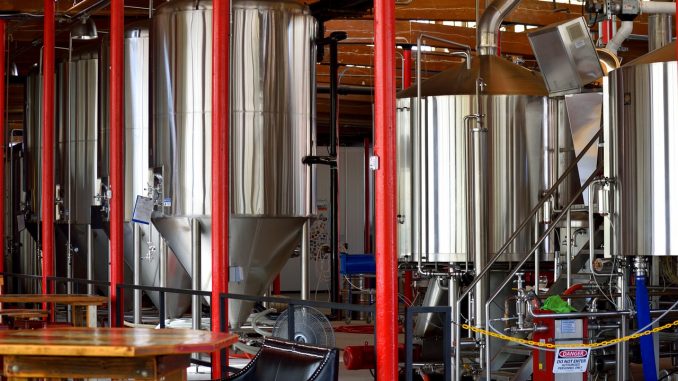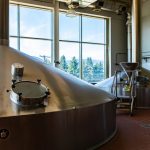
Maintaining the brewhouse and its facilities should always be at the heart of any well managed brewing operation whether it be a small-scale single fermenter or a massive brewing concern. Much of what is written here is aimed at the small-scale producer of beers and ciders but the principles on maintenance and cleaning will apply at all levels and the process also has similarities with maintenance of other types of beverage lines. It should be a topic that more than resonates too with home brewers.
Vessel Cleaning
Before each brewing day, hot water (above 65ºC) is passed through the fermenter and any connected lines. This helps with checking on the system integrity and serves as a rough view on whether all the items including pumps are working properly. Line leaks have to be identified and actively sought out, and valves need to be checked each day as to whether they can open or closed.
Leaks are easily spotted when you notice water pouring on the floor or spurting from orifices, or when there is excessive moisture around poorly fitting seals. It is a straightforward integrity test. It’s also relatively straightforward to fix and can mean just replacing or refitting gaskets and tightening clamps.
Modern breweries have cleaning-in-place (CIP) systems in combination with pressure washing facilities for external use to remove much of the dirt that accumulates both inside and outside the fermenter. A good caustic wash to remove the remains of the brewing process is an absolute. Sanitation using hypochlorite solutions should also be employed to make sure that no molds and bacteria develop after having an extreme wash. The final wash is a hot water rinse.
Pump Maintenance
Maintenance of pumps is critical for any brewing process. They should be routinely maintained so they do not break down during use and that also applies to any replacement pumps that might be needed at short notice if there is a failure. Maintenance engineering involves stripping these down and checking for wear and tear and that there are no obstructions. Check electric wiring for fraying and disconnection.
Water Line Maintenance
The water quality is checked routinely. Given it is the main ingredient of the brewing process, any compromising of quality will not help recover a brewed beer. Water used in brewing should be checked weekly in terms of its potability.
The Malt Mill
The malt mill is cleaned routinely and certainly after use so that dust from malting is removed. A build up will cause tainting of subsequent formulations. Dust and fragments cause the rollers to stop working. Cleaning thoroughly should ensure successful continued operation.
Electric Systems Testing
Control panels are used as focal points for the overall control of both semi-automated and automated systems. They are the control points for switches on pumps, agitators and mash paddles, heating and so on.
The wiring and any electrical components need to be routinely inspected by electricians. Dust is removed by a vacuum cleaner. A check for any moisture is needed to ensure nothing might short. That means that the whole control panel should be firmly encased and protected from any water, i.e. it should be waterproof.
Tool Calibration and Maintenance
Check all tools are available and in their right place. A number of businesses that use the Japanese management principle of Kaizen will manage all their tools this way. Instruments used for calibration should be routinely checked. This includes thermometers, refractometers, dissolved oxygen meters and calibration units.
Vessels and Motor Maintenance
All the motors powering the mash paddle, lauter tun rakes and any other mechanism is inspected every few months. All these units need to be checked after having been stripped down. All components should be free of wear. Examine for rust and faulty wiring.
Fermentation vessels
Check that fermentation vessels are able to hold pressure them. During any cleaning, check each gasket, valve and clamp for signs of wear and replace as necessary. Wash the outside of vessels weekly to prevent contamination during dry-hopping or adding adjuncts and other materials.
Filtration
Strip down filtration housings and check for particulates clogging filters and the housing. Conduct back flushing of the unit to remove fine particulates. Replace cartridges and sheets according to manufacturer’s instructions. Check the unit is allowing the free flow of hot water. Some units can be caustic washed.
The Role of Predictive Maintenance
Predictive maintenance is a very modern approach in production brewing and indeed in most manufacturing processes. Based on data analysis, preventive measures can be implemented which helps reduce major production stops, save money and time and also valuable resources.
All breweries use sophisticated machinery as part of the brewing process. This includes all the items we’ve discussed earlier such as pumps through to filtration equipment along with critical components we may not have mentioned. Any failure in their performance not only holds up the production process it could also mean the loss of a batch of beer or lager say. The cost is estimated to be in the thousands with repairs, spoilage and possibly loss of reputation if maintenance is poor and the equipment not maintained properly.
Examples of predictive maintenance include the following:
- Monitoring sensors to track equipment performance such as the temperature, pressure and vibration levels in items.
- Use of predictive analytics software that uses machine learning algorithms to analyze equipment performance data and predict potential failure
- Remote monitoring systems that enable breweries to monitor performance from anywhere.
- Maintenance management software for scheduling and track maintenance activities. This will generate work orders for maintenance personnel.
The Use Of Best Practices in The Maintenance of Brewing Lines
Define clear goals and objectives
Before implementing predictive maintenance, all breweries need defined and clear goals, and objectives for the program. It can include reducing downtime, improving equipment performance or increasing safety.
The need to obtain relevant data
The equipment may well have data monitoring activity, performance data, maintenance records with sensor readings. This data needs to be stored in a centralized system and analysed using predictive analytics software.
The maintenance strategy is implemented
Breweries need to develop a maintenance strategy based on the insights gained from their predictive maintenance program. This can include implementing a new maintenance procedure, upgrading equipment or replacing worn components.
Training employees
Employees need to be trained on new maintenance procedures and how to use the predictive maintenance technology. It may mean hiring new personnel and providing training to existing members.
Continuous monitoring and improvement
Using predictive maintenance is a continuous and ongoing process. The strategy needs to be reviewed periodically and adjustments made for new equipment or to ensure optimal performance. It’s feasible that the existing systems are not fully honed for the job at hand.
One of the main jobs is to make sure all documentation and manuals are organized, up to date including schematics and technical specifications.
Maintenance is an essential process and needs to be rigorously conducted to make sure that the brewing operation does not collapse through. The process starts at the top of the organization and no leadership has any excuse for not implementing a programme of looking after the lines.


FoodWrite’s guide on brewery maintenance emphasizes the importance of regular upkeep for brewing lines, ensuring optimal performance and consistent beer quality.